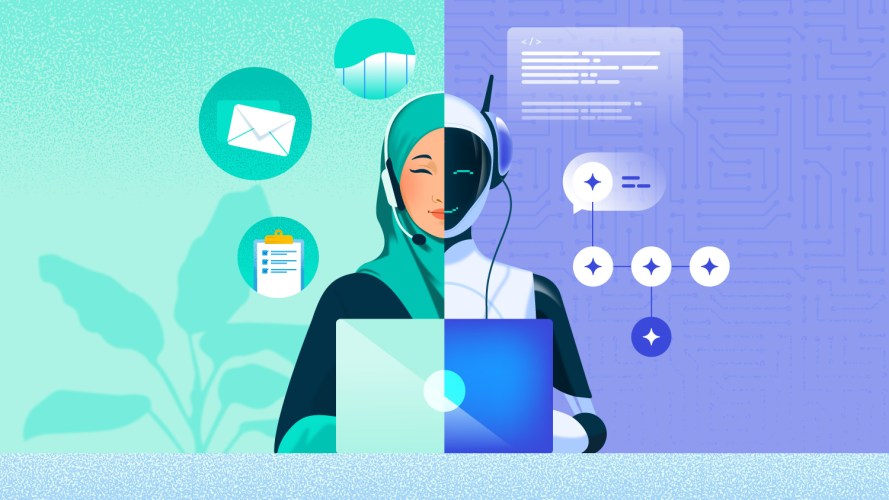If you’ve ever teamed up on a project with a talented coworker, you know that two minds are better than one. You likely each brought unique skills to the project, offered different perspectives, and challenged one another’s thinking. You might have even made each other look smarter.
Guess what? You can still collaborate with a supersmart colleague — only now that coworker is likely to be artificial intelligence (AI).
Human-AI collaboration is one of the most in-demand skills today, and your ability to master it can help you not only perform at a higher level, but stay relevant. In fact, Salesforce calls human-AI collaboration one of the 10 top enterprise skills that workers need to succeed.
“Humans who use AI are supercharged because they have all that knowledge at the tips of their fingers,” said Kaylin Voss, executive vice president of sales, Agentforce and Data Cloud, at Salesforce.
But like any collaboration, it’s a two-way street: It’s not just what you get from AI, but what you give. The more you understand how AI works, and the better you communicate with it, the more you’ll get out of it.
Let’s look at why this skill matters, and four ways you can master it.
How one Salesforce team works with AI agents — and how you can, too
Learn what happened when a support team treated agents not as tools but as true team members: It built trust, grew together, and got the most out of its agents.



What is human-AI collaboration?
Simply put, it’s the ability of people and AI to work together. It can apply to generative AI, predictive AI, chatbots, and AI agents. The magic lies in the different skills humans and AI bring to the equation.
AI excels at pattern recognition, data processing, and repetitive tasks, while humans offer empathy, critical thinking, creativity, and cultural context. “They play to each other’s strengths and augment each other’s areas of challenge,” said Lori Niles-Hofmann, a Toronto-based educational technology and AI transformation strategist, and founder of consulting firm 8Levers. “Together, they can achieve outcomes that neither could alone.”
Niles-Hofmann pointed to her own work as an example. Because many of her clients are in Europe, she often woke to a flood of emails sent overnight. After too many mornings playing catch-up, she realized there was a better way: An AI agent could manage her inbox. She created one and trained it on her previous emails so it would adopt her tone and voice.
Now, the agent sorts through emails and writes replies while Niles-Hofmann sleeps. In the morning, she reviews the agent’s work, clicks Send when the responses are spot-on, and edits those that don’t sound right. It’s a true collaboration: She and the agent work together to manage her email, and now she has more time to strategize with clients.
It wasn’t that hard, either. “I built an agent,” she said, “and I’m not that smart.”
The benefits of human-AI collaboration
The World Economic Forum predicts that collaboration between humans and AI could generate up to $15.7 trillion in economic value by 2030 — growth that will come from “amplifying human capabilities.”
“Everybody’s looking for a competitive edge, for productivity gains,” said Niles-Hofmann. “This is taking companies to the next level of achievement to be able to do what they could never do before.”
Salesforce is a good example. After Voss’s sales team incorporated Agentforce, the Salesforce platform for building and deploying agents, into its workflows, it shortened its sales cycle by 36%. The team closed deals faster. “We had faster access to knowledge on products and were able to find information in minutes — not days — so we could move faster in engagements,” Voss said.
But it isn’t just companies that benefit from human-AI collaboration. People who know how to collaborate with AI are more in demand. PwC’s 2025 Global AI Jobs Barometer found that jobs requiring AI skills — which infers the ability to collaborate with AI — grew 7.5% over last year, while total job postings fell by 11.3%. What’s more, these AI-focused jobs offer a wage premium of 56%, up 25% from last year.
4 ways to foster this collaboration
Human-AI collaboration doesn’t just magically happen. People can develop it, and companies can encourage it, in several ways.
1. Play around with the technology
The best way to learn about, and partner with, AI is to get your hands dirty. Play with the tools. Ask Google Gemini, for example, to produce a report, or ask Agentforce to help with a support request. Consider launching an agentic AI pilot to address one of your team’s pain points.
But for this exploration to work, people need the grace to fail. “You have to expect and embrace failure, and honor it within your organization,” said Niles-Hofmann. She gave a hypothetical example of a team that produces 50 widgets a week. When the team members start experimenting with AI, their output drops to 43 widgets. But as they grow more adept, their output returns to 50, and then exceeds that.
“Experimentation can’t be tied to compensation and benefits,” she said. “You can’t expect people to go through this massive change and transformation and just immediately rely on a technology they’ve never encountered before.”
The good news is that the more people use AI — particularly agents — the more likely they’ll trust the technology, according to recent Slack research.
2. Understand how AI works — and how to work with it
When Niles-Hofmann built her agent, she learned how the technology worked, which helped her better collaborate with it. It’s a good lesson: One of the best ways to understand AI is by getting under the hood.
But Voss, who also built her own agent, said that “coaching” it after it’s up and running is important, too. In other words, you need to continually assess your AI and make changes to get the best performance out of the technology. Ask yourself: Where are the instructions wrong? How can I refine the guidance to make it more valuable? Then, modify as needed.
Voss suggested carving out time each day to learn about AI. You can do this through learning platforms like Salesforce’s Trailhead, but also through podcasts, which is how Voss loves to learn. Her favorites? The AI Daily Brief, Lenny’s Podcast, ConTejas Code, and Hard Fork.
3. Write better prompts
You know the drill: You try a new AI tool. Its performance is … meh. You ditch it. The truth is, AI is still evolving. It doesn’t always perform as well as we’d like.
But you might also need to look at what you can do better. For many people, that means writing better prompts. Niles-Hofmann recommended a simple fix. At the end of each prompt, ask the AI: “Is there anything I’m not asking you? Is there something I should be telling you? Do you have any clarifying questions?” This gives the tool more information that it needs to excel.
It also helps you understand your collaborator better. “When I’m struggling with a tool,” Niles-Hofmann said, “I may not be prompting the AI in the way that it’s been trained.”
Build an agent on your own
Learn the basics of setting up and testing a conversational agent in Agentforce. Get started now on Trailhead, Salesforce’s free online learning platform.



4. Use critical thinking
To get the most out of AI, you need to understand what it can and cannot do. This includes fact-checking what it creates and anticipating hallucinations.
But you also need to understand AI’s limitations at scale. The Wharton School highlighted this in a recent study, when it asked two groups to generate ideas for a new product.
One group was told to work with OpenAI’s ChatGPT; the other relied solely on their own brains. The results? ChatGPT improved the quality of individual ideas, but led people within the group to generate similar ideas. Only 6% of the AI-generated ideas were considered unique, compared to 100% in the human group.
The ability to think critically — to know when to use AI and when human skills work better — is “probably one of the strongest traits you can bring to the human-AI relationship,” Niles-Hofmann said. “You still need a human being to look at the output, think about it, and question it.”
How to measure the success of human-AI collaboration
Niles-Hofmann said the simplest way to assess human-AI collaboration is to look at AI adoption rates. After all, people can only collaborate with AI if they’re using it.
But she also said other metrics for measuring human-AI collaboration are “really, really tricky” because the ways that companies measure work are changing as AI and agents become more prevalent.
Voss agreed. “Productivity and efficiency have become table stakes,” she said, adding that people should look instead at how AI affects growth. Her sales team’s win rate, for example, increased by 11% after it started collaborating with agents.
Voss also looks at employee satisfaction scores, which have increased, too. “I care more about how we’re getting better, instead of just faster,” she said.
The true value of the collaboration, however, may be hard to measure. Humans and AI working together can lead to better decision-making, accelerated innovation, and a competitive advantage — all things that are hard to quantify.
Collaboration is the key to success
With human-AI collaboration, the sum is usually greater than its parts. As Salesforce CEO Marc Benioff wrote recently, “The real magic is in the partnership: people and AI working together, achieving more than either could alone.”


























